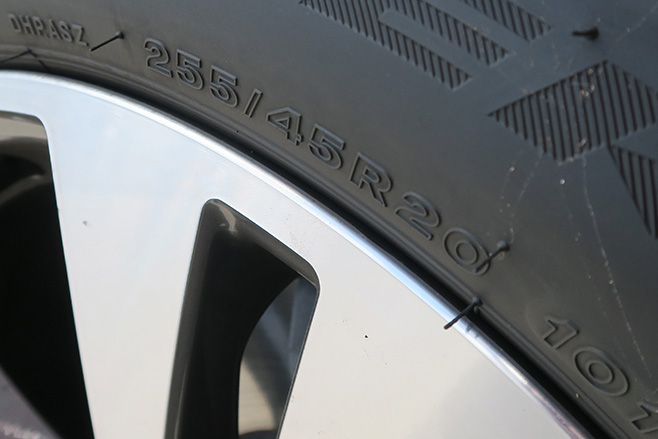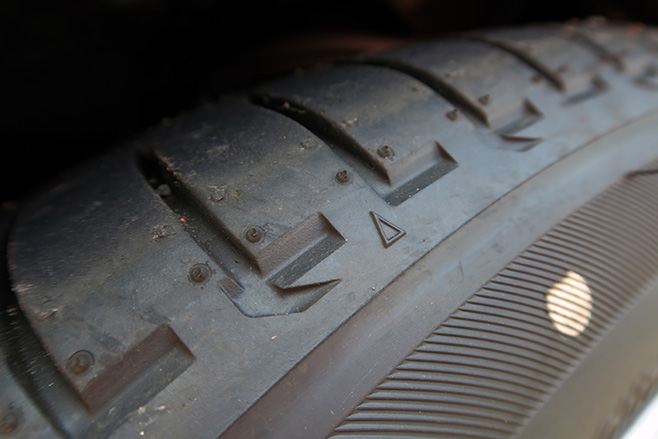
There’s nothing terribly sexy or glamorous about the four rubbery doughnuts that connect your car to the road, but when it comes to making sure it can accelerate, turn and stop safely and securely in all kinds of weather, having the right kind of tyre on your car makes all the difference.
But does size really matter? What do all those numbers and letters mean? When it comes time to replace your original tyres, how do you know your new set is the same as the ones that came off?
Let’s start with tyre size. All tyres will have a string of numbers and letters moulded into the side walls, usually following this format:
225/45 R19 92W (that’s what you’ll find on a new Mazda6 Atenza, for example).
| 225u00a0 | The first set of numbers is the width of the tyre in millimetres from sidewall to sidewall. In this the case the tyre is 225mm wide |
| 45u00a0 | The next figure is the sidewall height (the thickness of the tyre from the top of the wheel to the edge of the tread), expressed as an aspect ratio u2013 that is, as a percentage of the tread width. In this case the sidewall height is 45% of 225mm (or 101mm). When we talk about u2018high profileu2019 or u2018low profileu2019 tyres, this is what weu2019re referring to: the lower the number, the lower the profile. |
| Ru00a0 | This letter refers to construction. u201cRu201d is for u201cRadial constructionu201d where the steel and nylon cords that give the tyre its strength are laid out at 90 degrees to the centreline of the tread. Most tyres are made this way. |
| 19u00a0 | The third number refers to the diameter of the wheel rim in inches. Here we have 19 inches. |
| 92u00a0 | Next we have the load index which shows the tyreu2019s maximum load capacity – here itu2019s 92 which translates to 630kg. Thatu2019s right, the numberu2019s relation to an actual metric you can understand will make no sense to the everyman. You can, however, look up the tyre loading rating chart to see what your tyreu2019s number represents. |
| Wu00a0 | The final letter refers to the speed rating, indicating the tyreu2019s maximum safe speed when carring the maximum load itu2019s rated for. Again youu2019ll need to look up a reference chart to figure out exactly what each letter means, but generally speaking the later in the alphabet it is, the higher the speed rating. |

So what does it all mean? Is bigger actually better?
Well, larger wheel diameters, like 18, 19 and 20-inch, may look more appealing. They also provide a sportier driving experience with sharper steering response and better cornering grip.
But, when combined with low profile tyres, they can make for a bumpier and noisier ride. This makes sense; as the wheel gets bigger in diameter, the tyre’s sidewall shrinks, meaning there’s less cushioning between the road and the wheel and a less compliant ride.
With smaller wheel diameters, like 15, 16 and 17-inch, the ride is smoother. But as the ride softens, so too does steering response. Keeping the same tyre size is vital for keeping your speedo readings accurate too, and changing the wheel size, sidewall profile or even tread width can influence your speed readings.
Regardless of size, tyre pressure needs to be regularly checked. Good tyres are rendered useless if they’re under or over-inflated, with the car’s handling, tread life, braking, comfort, noise and even fuel consumption all affected by air pressure.
Tyres are best inflated cold so pick a servo that’s nearby and park really close to the air pressure gauge (nothing worse than a hose that doesn’t quite make it). Unscrew the stem cap on the tyre and connect the hose. If it’s a digital gauge set the required pressure. This is usually written on a sticker inside the driver’s door or glovebox. Look for the PSI – or Pounds Per Square Inch – suggested by your car maker. It’s usually a figure between 27 and 32.
And if your tyre bursts? Long gone are the days when every car had an identical spare wheel in the boot. In an attempt to increase cargo capacity and reduce weight many manufacturers are equipping cars with inflation kits, space saver spare wheels or run flat tyres instead.
The inflation kits are fiddly and work fine on small punctures but not on torn sidewalls or big gashes. They can be confusing to use for technical novices too.
Space savers are smaller, temporary spares that are subject to speed limits – often 80km/h – and limited distances. Don’t keep them on your car any longer than is absolutely necessary.
If your car is equipped with run-flat tyres there may be the temptation to drive on a puncture for extended distances. Thicker sidewalls mean the tyre won’t go visibly “flat” when air pressure is lost and you can roll on them for a limited distance and speed. With these, it’s vital to keep regular tabs on tyre pressure – especially if the vehicle isn’t equipped with a tyre pressure monitoring system.

These temporary solutions are fine if you never venture far from big cities, but attempting to cross the Simpson Desert necessitates the carriage of a full-size spare – help will be a long distance away.
Lastly, how do you know when your tyres need changing? Look around the sidewall for a small triangle symbol (pictured above) then move your hand across the tread face in line with that triangle.
You should feel some bumps in the deeper grooves of the tread – when these bumps become flush with the contact patch, that’s when your tread depth is no longer deep enough for the tyre to be effective and you need to get a new set of rubber.



